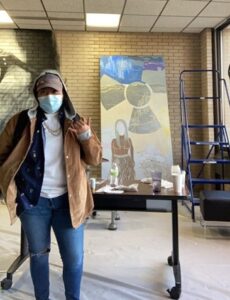By Tiana Martinez
Sonwai Wakayuta (Hualapai and Hopi) paints mirrored white lines, creating a mural from a maze-like trail of fingerprints. Her brushstrokes move in spirals, creating two paths that threaten to clash but never meet. Wakayuta says that a mural is a painting with its own breath and life, one that writes its own story. “It is like I am walking past strange history,” she says when she looks at her finished work.
The 20-year-old is an environmental studies student at Haskell Indian Nations University. She is also an artist and takes part in the Haskell art community by showcasing art reveals like the mural outside the Tommaney library, which she painted between early spring and late June of last year.
She used red, blue, white, black, yellow, and purple. Black and white are colors she considers must-haves in any project; they help accentuate and separate shapes and colors. Yellow and purple are Haskell’s colors and could be interpreted as a small tribute to the university and its contribution to Wakayuta’s life. Red and blue are bold colors that make shapes pop with intention. Many of her color choices match those used in Hopi art and crafts like gourds and lighting sticks. Wakayuta is Hopi and says that her mural should dedicate a portion of its beauty to Hopi inspiration.

“For me, this artwork is about internal conflict—the conversation I had to have with myself in order to move on from what was keeping me stuck,” Wakayuta says. “It was a form of chaotic release, like a kid on a scribbling journey across the walls.”
Wakayuta’s father is an artist who has worked in woodcarving, canvas painting, beading, yarn, and basket weaving. “Our family wasn’t wealthy enough to afford a proper studio for my dad to expand his talents in a professional environment, but his influence pushed me to think creatively,” she says. “The same goes for my mother, who challenges me to be successful in both professional and spiritual environments.”
Wakayuta and her parents got involved in grassroots projects, attending committee meetings and meeting with tribal liaisons to be vocal about the needs of the land when tourism project developments threatened the landscape. In 2017, she earned the responsibility of being an Earth Ambassador for UNITY, an environmental stewardship and leadership program for American Indian and Alaska Native youth. “Being an Earth Ambassador for UNITY simply highlighted my efforts in environmental stewardship,” Wakayuta says.
Wakayuta’s first influences are landscapes and her family—her father, mother, grandfather, and uncles. She also admires the artist T.C. Cannon for his bold pop art color choices and says she enjoys Fritz Scholder’s Indian lifestyle portrayals.
“Most of my early projects were made as gifts,” Wakayuta says. “One piece I made was for a class project to show appreciation to one artist [we] learned about throughout the semester. This piece was painted on the glass side of a beer bottle meant to challenge the Native American stereotype of drunken Indians. I painted a drunk version of myself acting savage in destruction. This particular project brought attention to the never-ending drunken labels. It brought attention to my personal leadership skills—hinting at hypocrisy.”
She shares another art project, an 8-by-4-foot mural that is dedicated to raising awareness about uranium mining in the Grand Canyon.

“I was really excited to start this one because the Grand Canyon is home for me and other Hualapais. It is like our wondrous backyard filled with exciting adventures. This mural is meant to raise eyebrows and look big and cartoonish. That way it plays along with the other stereotype of being a forgotten Indian.”
She says her early projects also served as a form of practicing communication and rekindling connections to express nonvocal feelings about loved ones.
“In public, I try to remember my manners and who I am representing, how I am being represented. When I am asked to facilitate, moderate, speak, or be interviewed, I learned it was usually better to say yes than to say no and be left wondering about what could have been. I also learned to prioritize mental health over the opportunities that present themselves. You do not want to bite off more than you can chew.”
This mindset also applies to navigating the professional art world. “The only way you are going to be remembered is if you are different. Different knows how to catch an audience’s attention. The way I do that is with vocal storytelling. It’s about the ugly and uncomfortable.”
Wakayuta shares the common themes found in all of her artwork and how they point back to herself, the creator. “In a way, how I heal myself is how I accidentally heal others. My themes show the land. They show the power of abuse. They show off the power of resilience.”

Tiana Martinez is a transfer student studying creative writing with a focus on poetry. An enrolled member of the Yankton Sioux Tribe (Ihanktonwan Dakota), she is also Ponca and Turtle Mountain Ojibwa.